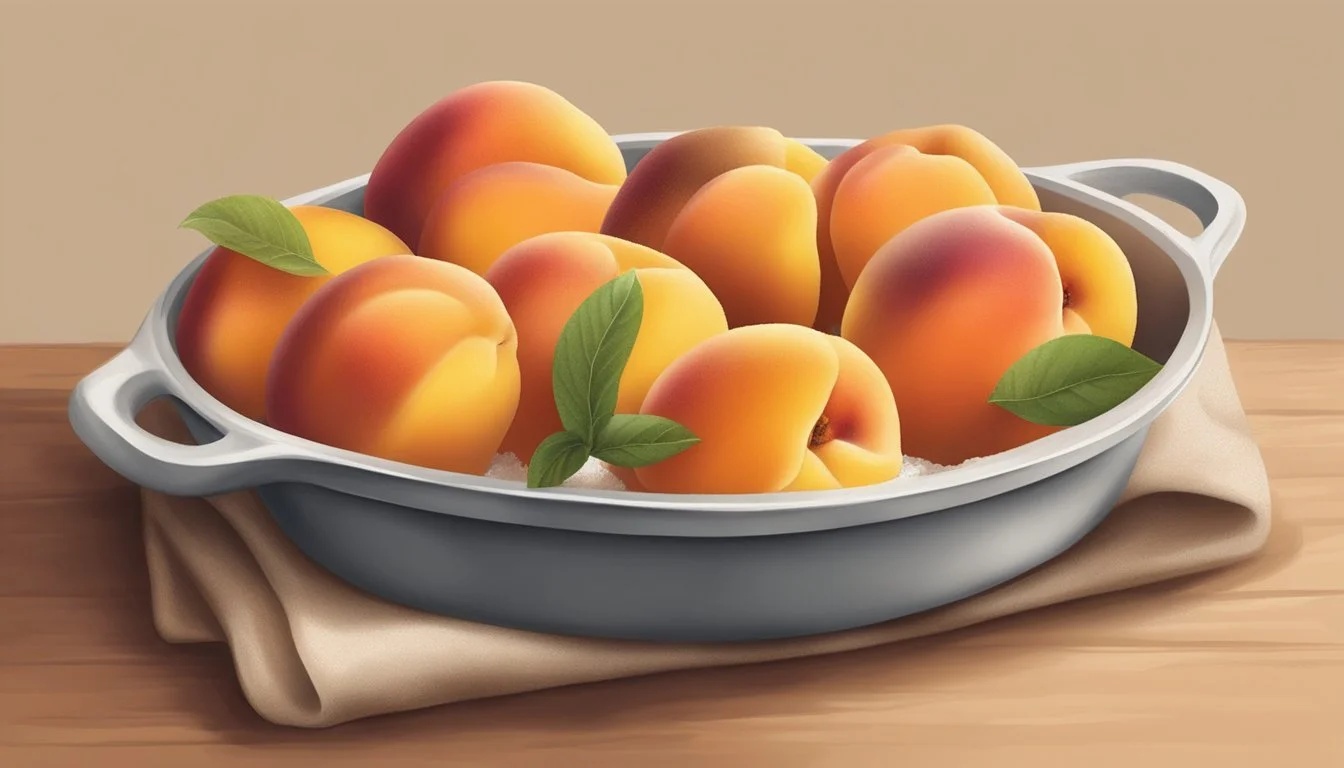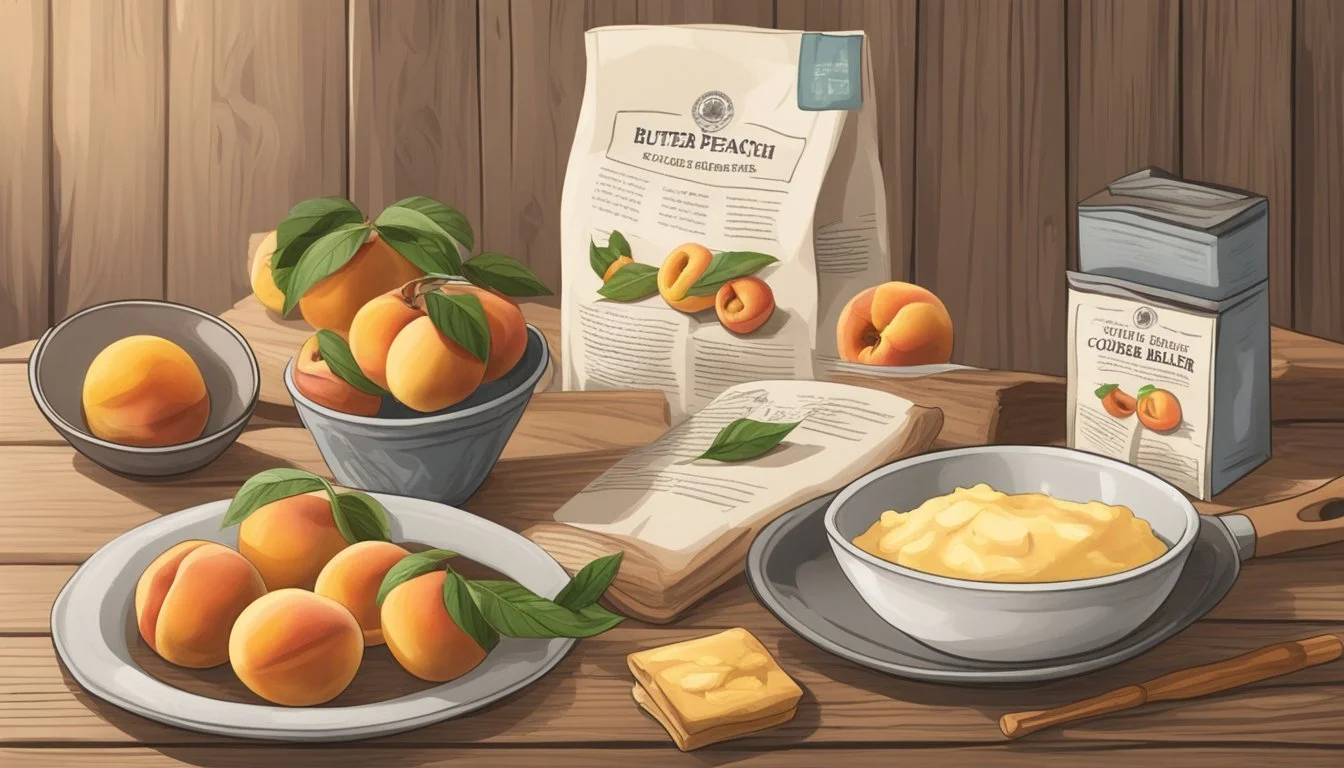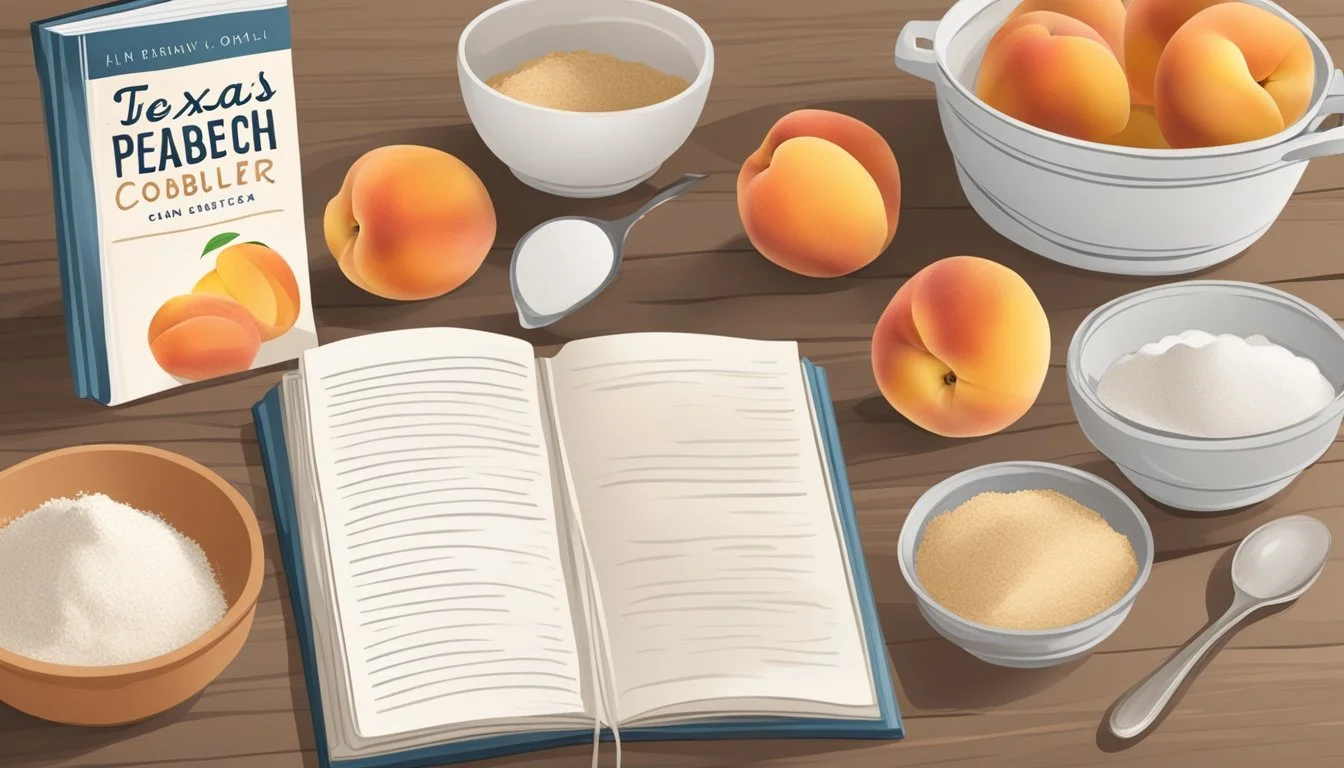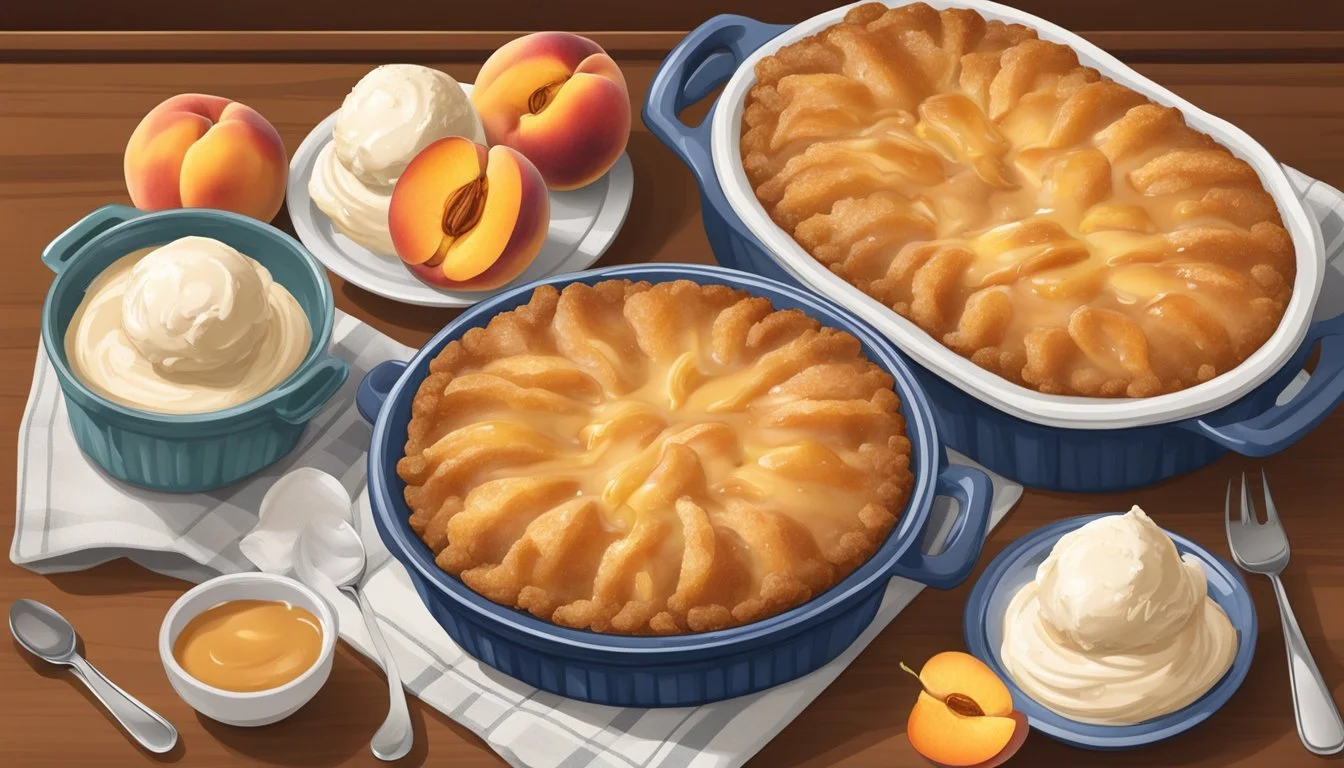How to Make a Texas Peach Cobbler
Easy Homemade Recipe
Texas Peach Cobbler is a staple dessert that evokes warmth and comfort with every bite. This quintessential Southern treat is marked by its sweet, juicy peaches and a fluffy, biscuit-like topping that comes out golden brown from the oven. Making a traditional Texas Peach Cobbler involves a harmony of simple ingredients and a straightforward process, resulting in a dessert that is both heartwarming and delightfully satisfying.
The beauty of peach cobbler lies in its rustic simplicity and the flexibility to use either fresh or canned peaches, allowing one to enjoy it year-round. The process begins with melting butter in a baking dish, preparing a batter that will rise to cradle the peaches as it bakes. Seasonings such as cinnamon or a hint of lemon zest can be added to the fruit, enhancing the natural sweetness and adding layers of flavor.
In Texas, peach cobbler is often served with a dollop of whipped cream or a scoop of vanilla ice cream on the side, making it the perfect ending to any meal. Its crowd-pleasing nature makes it a favorite at family gatherings and barbecue dinners, embodying the essence of Southern hospitality.
Origins and Significance
The Texas Peach Cobbler is a cherished dessert deeply rooted in Texan cuisine. It represents the ingenuity of American settlers in the 1800s who adapted classic European pie recipes under the constraints of frontier life. The innovation turned cobblers into a symbol of resourcefulness, using whatever fruit was available, often peaches during the peach season.
Peach Season in Texas: Spanning from May to August, peach season is a pivotal time in the state. It heralds the availability of fresh peaches, a key ingredient in the authentic Texas Peach Cobbler.
Texan Adaptation: While cobbler recipes vary, the Texas version is distinct for its fluffy, cake-like topping that becomes a golden-hued delight upon baking. This contrasts with the biscuit or pastry toppings seen in other styles.
Cuisine Significance:
Simplicity: Reflects the simplicity and heartiness of Texan cuisine.
Hospitality: A symbol of Southern hospitality, embodying a communal spirit.
Local Produce: Showcases local agriculture, particularly Texan peaches, celebrating the state’s bountiful produce.
In essence, Texas Peach Cobbler is not just a dessert, it's a testament to Texan culture, emphasizing local ingredients and a hospitable spirit. It mirrors the state's historical landscape and stands as a proud tribute to the ingenuity of its people.
Selecting Quality Ingredients
For a Texas Peach Cobbler that stands out, one must select the best ingredients, starting with peak-condition peaches and extending to the purity of your baking essentials.
Choosing the Right Peaches
Selecting ripe and juicy peaches is crucial for the cobbler. For a fresh fruit approach, choose peaches that yield slightly to pressure, which indicates ripeness. They should have a fragrant aroma and a vibrant, unblemished skin. If opting for canned peaches, look for ones that come in heavy syrup as this often preserves the fruit's flavor and adds to the dessert's sweetness.
Flour, Sugar, and Other Dry Ingredients
A successful cobbler requires precise dry ingredients. Use all-purpose flour for a reliable structure. Measure the flour accurately, leveling off the measuring cup for consistent results. Combine with granulated sugar, which adds sweetness and a golden-brown crust when baked. Include a pinch of salt and the correct amount of baking powder to ensure a perfect rise. Here is a quick reference:
All-purpose flour: for structure
Sugar: for sweetness and browning
Salt: to balance flavors
Baking powder: for leavening
Dairy and Add-ins
Dairy introduces richness and binds the cobbler together. Use unsalted butter, melted and cooled, to control the dessert’s sodium content and flavor profile. Whole milk gives the batter a creamy consistency; however, low-fat milk can be used for a lighter version. To enhance the cobbler's taste, incorporate a hint of vanilla extract for depth of flavor. Optionally, a dash of cinnamon or lemon zest can be added for an aromatic twist.
Required Equipment
To ensure a successful Texas Peach Cobbler, having the right equipment is crucial. One should gather all necessary tools before beginning to ensure the process runs smoothly and efficiently.
Baking Dish Selection
Selecting the appropriate baking dish is paramount in achieving the cobbler's desired texture and size. For a classic Texas Peach Cobbler, a 10-inch deep-sided cast-iron skillet is often preferred as it provides even heat distribution and adds a hint of flavor common to Southern cooking. However, if a skillet is not available, one can also use a 9x13-inch baking pan. If using a baking pan, ensure it's greased or lined with foil to prevent sticking and to make cleanup easier.
Mixing Tools
A variety of mixing tools will be required to prepare the cobbler mixture. One will need at least two medium bowls—one for dry ingredients and one for the wet—to assure proper mixing of components. It is also advisable to have a whisk or a spoon for stirring the mixture. For blending the butter with other ingredients, having a pastry cutter or a simple fork can be advantageous.
Measuring Accurately
Precise measurement of ingredients is key to the delicious outcome of the cobbler. It's recommended to have a set of measuring cups and spoons on hand. Additionally, having a kitchen scale can provide the most accurate measurements, especially for ingredients like flour and sugar. If a recipe calls for peaches in syrup or other liquid ingredients, a liquid measuring cup is advisable for accuracy.
Remember to preheat the oven to the recipe's recommended temperature and have a wire rack ready for cooling the cobbler after baking. With all equipment properly prepared, the process of making the cobbler will be more efficient and pleasant.
Preparing the Dish
The success of a Texas Peach Cobbler lies in the meticulous preparation of each component and the careful assembly of layers. Ensuring the oven is preheated and ingredients are correctly proportioned guarantees a delightful outcome.
Preparation of Ingredients
One begins by preheating the oven to 350 degrees F. Peaches must be washed, peeled, and sliced to uniform thickness to ensure even baking. If using canned peaches, they should be well-drained. The remaining dry ingredients, which often consist of flour, sugar, ground cinnamon, and a pinch of salt, need to be proportioned as per the recipe.
Peaches: Peel and slice or drain if canned
Dry Ingredients: Measure according to the recipe
Assembling the Cobbler
In an oven-safe dish, a stick of butter is typically melted either in the preheating oven or a saucepan. In a separate bowl, dry ingredients are mixed, then milk is added to form the cobbler batter. This batter is then gently poured over the melted butter without stirring. Finally, the peaches are evenly layered on top of the batter.
Melt butter in dish or saucepan
Mix dry ingredients and milk to create the batter
Pour batter over butter, then layer with peaches
Baking the Cobbler
With the cobbler assembled, it's placed in the preheated oven. The bake time can range, but an average guideline is between 40 to 45 minutes or until the top is golden brown and the peaches are bubbly. It is vital to monitor the cobbler as it bakes to avoid over-browning.
Bake time: 40 to 45 minutes
Oven Temperature: 350 degrees F
It is recommended to check the cobbler at the 30-minute mark to assess its progress. The cobbler is ready when it boasts a golden-brown crust with a bubbling sauce beneath it.
Serving Suggestions
When serving Texas Peach Cobbler, presentation and choice of accompaniments can elevate this classic dessert. The dish is best served warm and is a quintessential part of summer dessert recipes, often portioned into hearty servings.
Presentation
A Texas Peach Cobbler should be served warm with the peaches soft and the topping golden-brown. For an aesthetic touch, one can scoop the cobbler into individual bowls or plates. Drizzling a little peach syrup over the top can add both flavor and a visually appealing gloss. Garnishing with a sprig of mint or a dusting of cinnamon can also enhance the visual allure of this dessert.
Accompaniments
There are several accompaniments that complement the flavors of Texas Peach Cobbler:
Vanilla Ice Cream: A scoop of vanilla ice cream melting over a warm serving of peach cobbler is a classic pairing.
Whipped Cream: Lightly sweetened whipped cream offers a creamy texture that contrasts the cobbler’s richness.
Beverages: A cup of coffee, tea, or even a glass of dessert wine can be paired with the cobbler for a complete dessert experience.
Nutritional Information
When preparing a homemade Texas Peach Cobbler, individuals can expect variations in nutritional values depending on specific ingredients and portion sizes. However, a traditional recipe typically includes peaches, sugar, flour, butter, milk, and a leavening agent such as baking powder. Below is an approximate nutritional breakdown per serving for a standard peach cobbler:
Calories: Traditional recipes can vary, but a serving generally has around 300-500 calories.
Total Fat: A serving may contain 10-20g of total fat, with saturated fat constituting 5-10g, depending largely on the amount of butter used.
Cholesterol: Depending on the dairy ingredients, cholesterol content can range from 20-40mg per serving.
Sodium: A typical serving contains about 200-300mg of sodium.
For more detailed figures:
Total Carbohydrate: About 40-60g, with a considerable part of that coming from sugar.
Dietary Fiber: Provided mainly by the peaches, it averages 2-4g per serving.
Total Sugars: Sugar content can be high, often around 30g, unless adjusted for a healthier recipe.
Protein: Roughly 2-5g per serving, largely provided by the milk or dairy substitute.
Vitamins and minerals:
Vitamin C: A nutrient present due to the peaches, could contribute to 10-15% of the recommended daily intake.
Calcium: Varies according to the use of milk or fortified alternatives, offering about 5-10% of daily needs.
Potassium: Provided by the peaches, each serving may include 5-10% of the recommended intake.
Note that trans fat is not naturally present in significant amounts in these ingredients but could be found in processed alternatives. For a healthier version, cooks may opt for whole grain flours, reduce the sugar, and use unsaturated fats.
Storage and Leftover
When it comes to preserving Texas Peach Cobbler, proper storage is essential to maintain its freshness and texture. The methods used can significantly influence the cobbler's taste and safety when consumed later on.
Storing the Cobbler
Once the peach cobbler has cooled to room temperature, it should be covered with plastic wrap or aluminum foil to protect it from air exposure. To ensure the cobbler retains its quality, one may store it in the refrigerator for up to 3-4 days. Restaurants often employ plastic wrap or airtight containers when storing desserts (What wine goes well with desserts?) like peach cobbler to prevent contamination and staling.
Reheating Guidelines
When reheating leftover peach cobbler, the goal is to restore the dessert's warm and comforting texture without drying it out. For best results, reheat the cobbler in an oven preheated to 350°F (175°C) for about 20 minutes or until thoroughly warmed. If reheating an individual serving, a microwave can be used, heating in short intervals of 20-30 seconds to avoid overheating.
It's important to check the cobbler before reheating to ensure it has been stored correctly and is still in good condition to prevent foodborne illness.
Food Pairings and Variations
Texas peach cobbler is a versatile dessert that can be adapted to suit various regional preferences and ingredient availability. Innovative pairing choices only enhance this Southern classic.
Regional Variations
Different regions may opt to tweak the traditional Texas-style peach cobbler recipe to align with local tastes and fruit harvests. For example, in areas where peaches are more tart, additional light brown sugar or brown sugar can be used to balance the flavors. Some regions might prefer a peach crisp with a crumbly topping instead of the standard biscuit crust, incorporating oats or nuts for added texture.
Alternative Ingredients and Substitutes
Should the original ingredients be unavailable or if a personal dietary consideration comes into play, various substitutions can be utilized.
Buttermilk might be replaced with a mixture of milk and lemon juice or vinegar, providing a similar tanginess.
In the event kosher salt is preferred over table salt, there's a simple conversion: 1 teaspoon of table salt can generally be substituted with 1 1/4 teaspoons of kosher salt.
To cater to health-conscious guests, light brown sugar can take the place of brown sugar in the filling, offering a more subtle sweetness.
Employing these variations and pairings respects the essence of the homemade peach cobbler while allowing for individual expression and creativity in the kitchen.
Community and Sharing
Texas Peach Cobbler is not just a dessert; it's a communal experience that delights the palate and brings people together. Sharing one's baking journey and the final product can enrich connections within communities both online and offline.
Sharing on Social Media
Bakers often turn to social media to showcase their version of Texas Peach Cobbler. Platforms such as Facebook and Instagram serve as popular outlets where they can post photos of their dessert and exchange tips. Here's a simple guide to sharing:
Photo Quality: High-resolution images of the peach cobbler that show its texture and color can be appealing and garner more likes and shares.
Captions: Including a brief story or the inspiration behind baking the cobbler can make posts more engaging and personal.
Hashtags: Use related hashtags like #PeachCobbler and #TexasDesserts to reach a wider audience interested in dessert recipes.
Engaging with Other Bakers
Beyond showcasing the results, bakers engage with others by:
Asking for Feedback: Encouraging fellow bakers to suggest improvements or variations to the recipe.
Sharing Tips: Offering own insights on perfecting the peach cobbler, such as the ideal peach ripeness or alternative toppings.
Recipe Exchange: Swapping dessert recipes with others can inspire new baking adventures and broaden one's dessert repertoire.
Connecting with a community over a mutual love for dessert recipes enriches the baking experience and exchanges knowledge, fostering a supportive and inclusive environment.
Conclusion
Texas Peach Cobbler is a delightful dessert that encapsulates the essence of Southern comfort food. This dessert, which can be categorized under both puddings and pies, is a perfect conclusion to any meal. Making it requires attention to detail and reverence for the traditional flavors that make it uniquely Texan.
The authenticity of the dish is preserved through the use of ripe, juicy peaches, which are the star ingredient. These are coupled with a light, fluffy batter and a perfectly crisp crust. When baked, the combination yields a dessert that is both satisfying and deceptively simple in its complexity.
One should use quality ingredients to ensure the best flavor. Fresh peaches are ideal, but when not in season, canned peaches can substitute well if thoroughly drained. It is important not to overlook the balance of sweetness and acidity, which is usually achieved by adding a touch of lemon zest or cinnamon.
When serving Texas Peach Cobbler, it’s often enjoyed with a scoop of vanilla ice cream or a dollop of whipped cream, enhancing its warm and comforting qualities. The dessert should be served warm to allow the flavors to meld together pleasingly.
In preparing this cherished course, one appreciates the blend of textures and flavors that define a well-crafted peach cobbler. Whether it’s for a family dinner, a festive occasion, or simply as a sweet treat, Texas Peach Cobbler stands as a testament to traditional Southern baking. It is a confident choice for anyone looking to indulge in a classic American dessert.









